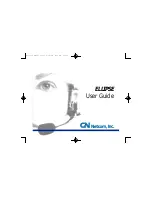
Installation into Full-Coverage & Flip-front Style Helmets
The full-coverage type of helmet presents special challenges for headset instal-
lation. If you do not feel you are up to the task, you may send your "un-modi-
fied" helmet to our factory in Tucson and we will perform the installation for a
nominal fee. (Please call first to insure that J&M is able to install a headset
into your particular brand/model of helmet.)
1. Most full coverage-style helmets have cheek pads or a complete nose sec-
tion that can be removed. Carefully do so at this time, paying special attention
so as not to break or damage any of the polystyrene parts.
2. Using a headset speaker as a guide, mark the circular pieces of styrene to
be removed from the back of the ear area of the nose section or the cheek pad.
See Figure 7.
With an Exacto
®
knife, cut a hole slightly smaller than the speak-
er so that the speaker will "press fit" into the hole without damaging the
styrene. An airtight seal is necessary to preserve bass response as the sound
pressure from the back of the speaker housing should not be allowed to mix
with the sound pressure from the front. Also, be careful not to cut or damage
the fabric lining.
3. Locate an area in the nose section just to the left of center to mount the
microphone.
See Figure 8.
Make sure that this placement will not interfere with
any venting mechanisms or other parts of the helmet upon re-installation of the
nose section.
Using an Exacto
®
knife, cut a hole of sufficient size to allow the microphone
to be mounted through the nose section and be pressed against the inside
shell.
See Figure 9.
Insert the microphone cartridge through the hole from the
back side, install the rubber boot and push the mike back into the hole from
the front side.
See Figure 10.
If the helmet is the flip-front style:
Position the boom microphone clamp on
the left side of the helmet so that the microphone lines up with the wearer’s
mouth. Tighten the clamp with the rubber spacer in place.
See Figure 13 —
Flip-Front.
4. Place the speakers into the cheekpads.
See Figure 11.
5. Clean the inside of the helmet shell where the speakers and microphone will
be positioned with a cloth dampened with alcohol. Peel the backing from each
supplied Velcro pad and press it into the proper position for the speakers and
microphone to contact when the helmet is re-assembled.
6. Reinstall the nose section and/or cheek pads. Push the speakers and micro-
phone firmly against the Velcro
®
pads.
7. Mount the clamp in the proper position on the left bottom edge of the hel-
met and tighten the clamp with the rubber friction spacer in place.
See Figure
13.
8. Using the included wooden tool, be careful to push the wires into the gap
between the helmet liner and shell.
See Figure 14.
Notes:
When using your intercom system, regardless of headset brand or type, it is impor-
tant to turn the intercom volume level high enough for comfortable conversation, but not
any higher. Unnecessarily high intercom volume levels will only increase the unwanted wind
and background noise you may experience.
J&M Bluetooth Helmet Headset Installation Instructions
WARNING!
Helmet speakers may not be legal in all jurisdictions. Check your local laws BEFORE using this product. J & M Corporation cannot control the circumstances surrounding the sale of this equip-
ment, the quality of installation, or the specific helmet into which this equipment is installed. Accordingly, J & M Corporation makes no warranties, expressed or implied, related thereto. A helmet with this
equipment installed may not protect the user from injury. The user assumes all liability in conjunction with accidents, injuries or losses of any kind arising out of the use of this product. Additionally, this
product should not be used in any way that would impair the user’s ability to hear traffic or other noises. Accordingly, the volume should be kept low or off, depending upon the circumstances.
7
Figure
8
Figure
9
Figure
10
Figure
11
Figure
13
Figure
14
Figure
6A. Installation Instructions
For Full Coverage & Flip Front Style Helmets
Flip-Front
Rubber Friction Spacer
Full Face
























